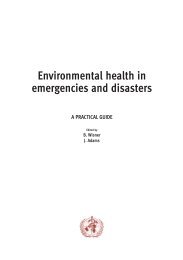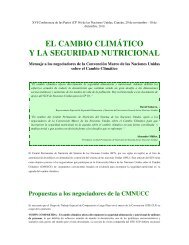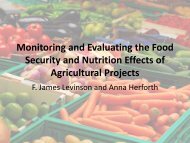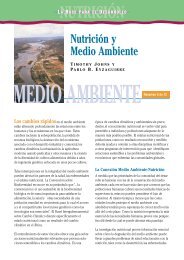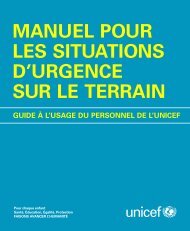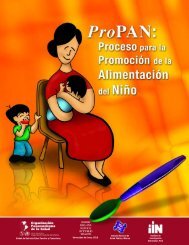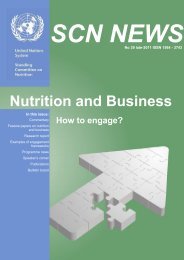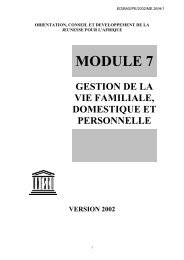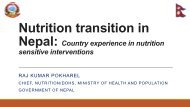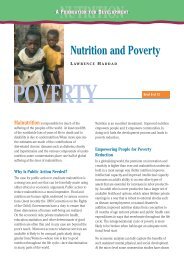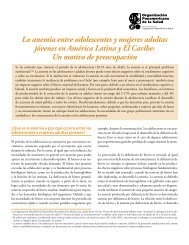SCN News No 36 - UNSCN
SCN News No 36 - UNSCN
SCN News No 36 - UNSCN
Create successful ePaper yourself
Turn your PDF publications into a flip-book with our unique Google optimized e-Paper software.
www.unsystem.org/scn 35 TH <strong>SCN</strong> SESSION RECOMMENDATIONS 55<br />
13. The LNS recommends that community based strategies for breastfeeding promotion should be integrated into health system support<br />
strategies. One such strategy is the Baby Friendly Hospital Initiative (BFHI), launched by WHO and UNICEF in 1991, following the<br />
Innocenti Declaration of 1990. BFHI is based on the Ten Steps to Successful Breastfeeding. The first BFHI material was published in 1992, the<br />
most recent revised BFHI package from 2006, which takes account of HIV concerns, is available online. The evidence base for the Ten<br />
Steps is available online.<br />
14. LNS considers that in "food secure" populations, evidence shows that nutrition education improves complementary feeding which<br />
improves linear growth. How to promote the adoption of optimal complementary feeding practices, is described in a document providing<br />
the scientific rational of each guideline; see PAHO/WHO (2003) Guiding principles for complementary feeding of the breastfed child. Division<br />
of Health Promotion and Protection/Food and Nutrition Program. PAHO/WHO:Washington DC (online). One of the guidelines is<br />
on the use of fortified complementary foods or vitamin-mineral supplements for the infant, which in summary states that it is difficult<br />
to meet the recommended intakes of certain key nutrients (particularly iron, zinc and calcium) through complementary food mixtures<br />
without the inclusion of animal food sources. As these increase the cost and/or may not be culturally appropriate, the use of either fortified<br />
complementary foods or vitamin-mineral supplements should be considered "as needed" in most settings. Even in developed<br />
country settings the prevention of anaemia in children has largely been achieved by fortifying complementary foods.<br />
15. The LNS considers there is sufficient evidence that iron-folate supplementation during pregnancy reduces anaemia at term, and that<br />
their effective use at scale would reduce maternal mortality by 23%. Although most if not all countries have a national policy to give<br />
iron supplements to women during pregnancy, anaemia rates in women of reproductive age are greater than 50% in all of the <strong>36</strong> countries<br />
that harbour 90% of global stunting. Coverage of iron supplements in women during pregnancy, although rarely measured or<br />
monitored, are often reported to be around 50%, but in reality are likely to be much lower; see Mason J, et al (2001) The Micronutrient<br />
Report. The Micronutrient Initiative:Ottawa (online). The UN agencies recommend that in populations where more than 40% of women<br />
of reproductive age are anaemic, supplementation with 60 mg iron and 400 mcg of folic acid should be given to all women during pregnancy<br />
and lactation for at least three months; see UNICEF/UNU/WHO (2001) Iron Deficiency Anemia: Assessment, Prevention and Control.<br />
A guide for programme managers (online). The UN also recommends that strategies to control anaemia should consider infection control in<br />
addition to increased dietary intake; see WHO/UNICEF (2004) Focusing on Anemia: Towards an integrated approach for effective anemia control.<br />
Joint UNICEF/WHO statement (online). Care is also needed in the distribution of iron supplements in malaria endemic areas, and a<br />
joint WHO/UNICEF Statement is available on this (online).<br />
16. Anaemic mothers are rarely just iron deficient, but instead have multiple micronutrient deficiencies. For these reasons a multiple<br />
micronutrient supplement (MMS) that could potentially replace the iron-folic acid supplement has been developed for trial purposes;<br />
UNICEF/WHO/UNU (1999) Composition of a Multi-Micronutrient Supplement to Be Used in Pilot Programmes among Pregnant Women in Developing<br />
Countries (online). Although the LNS concluded that use of MMS in pregnancy can reduce the risk of low birth weight, and recommended<br />
it as a core intervention, there is still no UN guidance on the use of MMS in non-emergency situations. UN agencies have issued<br />
a joint statement which covers the use of MMS in populations affected by an emergency; see WHO/UNICEF/WFP (2007) Preventing<br />
and controlling micronutrient deficiencies in populations affected by an emergency. WHO:Geneva (online).<br />
17. Although comprehensive programme guidance on fortification of food exists (WHO/FAO (2006) Guidelines on food fortification with<br />
micronutrients. Allen L, de Benoist B, Dary O, Hurrell R (Eds), WHO:Geneva (online)), specific guidance on how to fortify complementary<br />
foods, especially in developing country settings is more difficult to find. Although no adverse effects of increasing iron intake<br />
through fortification or home fortification of complementary foods have been reported, large-scale studies that include sufficient numbers<br />
of iron-replete children are still lacking. Further research is needed to verify the safety of iron-fortification strategies, particularly in<br />
malarial areas; Dewey KG (2007) Increasing iron intake of children through complementary foods. Food Nutr Bull. 28 (4 Suppl):S595-609.<br />
18. There is considerable guidance available on the elimination of iodine deficiency; see ICCIDD/MI/UNICEF/WHO (1995) Salt Iodization<br />
for the Elimination of Iodine Deficiency. Mannar V and Dunn J. International Council for the Control of Iodine Deficiency Disorders<br />
(online). Universal Salt Iodization was the main focus of the last edition of the <strong>SCN</strong> <strong>News</strong>, online.<br />
19. Guidelines are available on the use of zinc supplements in the treatment of diarrhoea; see USAID/UNICEF/WHO (2005) Diarrhea<br />
treatment guidelines including new recommendations for the use of ORS and zinc supplementation for clinic-based healthcare workers. WHO:Geneva (online)<br />
20. A variety of sources of guidance on the control of vitamin A deficiency is also available online through the Nutrition in Health and<br />
Development website at WHO.<br />
21. Guidelines on the use of RUTF in community settings are available; see Valid International (2006) Community-based Therapeutic Care<br />
(CTC): A Field Manual (online).<br />
22. These context specific interventions are more related to the three groups of underlying causes (Food, Health and Care) of malnutrition,<br />
which operate at the household and community level. The 1990 UNICEF Nutrition Strategy proposed the use of the Triple A<br />
method (Assessing the problem, Analysing the causes and implementing appropriate Actions) in order to decide which actions should<br />
be taken to improve nutrition, i.e. the decision on which actions to take is context specific. The Analysis part of the Triple A is informed<br />
by the use of a Conceptual Framework which identifies the basic, underlying and immediate causes of malnutrition. The<br />
three groups of underlying causes are each essential but alone insufficient, meaning that for maximum impact, all three potential problem<br />
areas have to be resolved. The Basic causes are related to the natural resources available to the nation, the national income per capita,<br />
the quality of the human capital and of the institutions that provide governance. See Jonsson U (1995) Ethics and Child Nutrition.<br />
Food and Nutrition Bulletin 16(4), online. The immediate level of causality includes individual disease status and nutrient intake, and is<br />
where the LNS "core" or essential nutrition interventions operate at.<br />
23. Guidance on how to classify food security of a specific population in a defined geographic area is available from a variety of sources;<br />
see WFP (2005) Emergency Food Security Assessment Hand Book (online), IFRC (2006) How to conduct a food security Assessment (online). The<br />
Food Insecurity Vulnerability Information and Mapping System (FIVIMS) (www.fivims.org) promotes cross-sectoral analysis of underlying causes<br />
of food insecurity, hunger and malnutrition for improved policy making, programming and action. The Integrated Food Security Phase Classification<br />
(IPC) has developed a concrete set of indicators of food security. This innovative tool for improving food security analysis and<br />
decision-making, provides a standardized scale that integrates food security, nutrition and livelihood information into a clear statement<br />
about the nature and severity of a crisis and implications for strategic response (www.ipcinfo.org). The IPC has been developed to help




